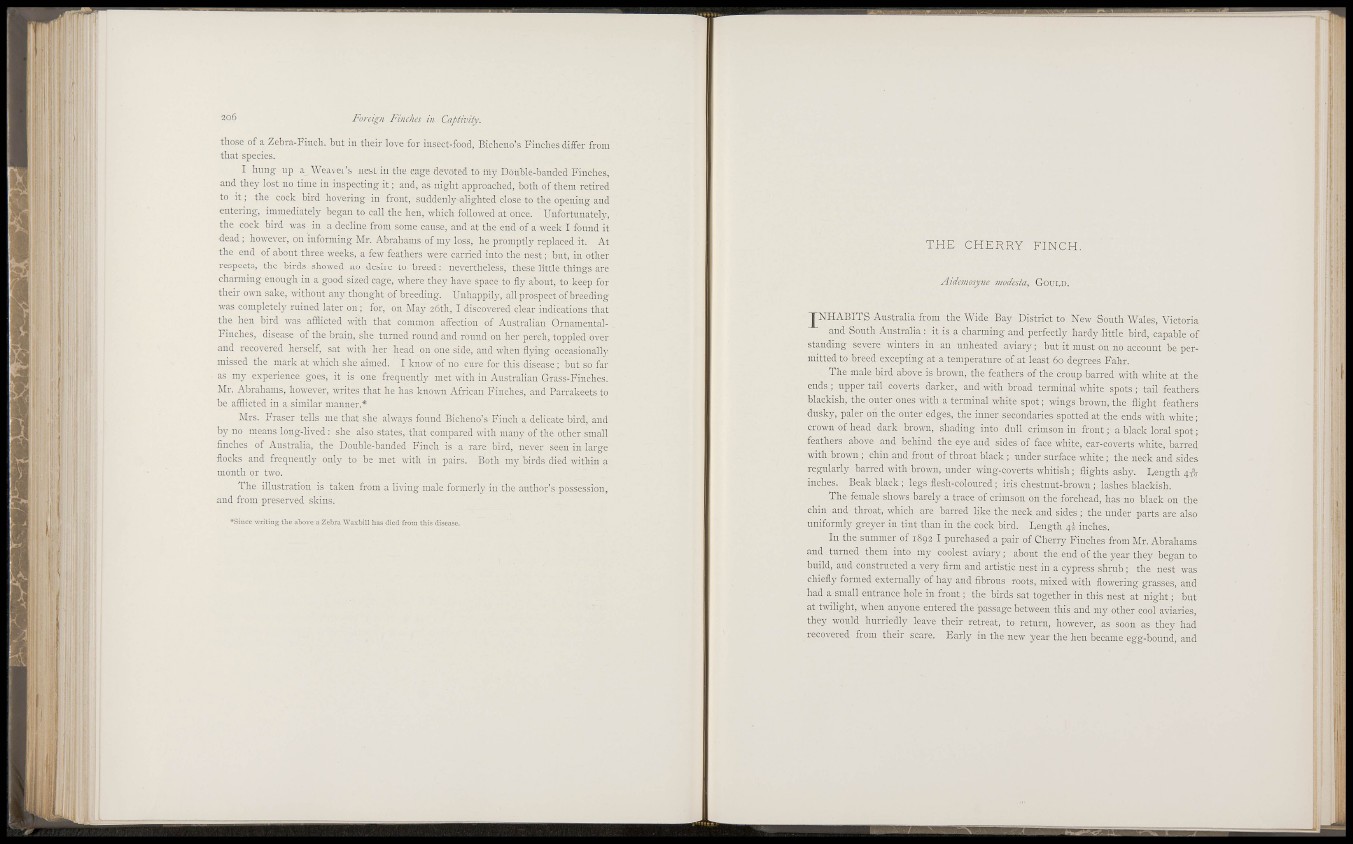
I • .is
!• 'iiil'i
HI!
il'
i
! I
r ^ i '
206 Foreign Finches in Captiviiy.
those of a Zebra-Fincli. but in their love for insect-food, Bicheuo's Finches differ from
that species.
I hung lip a Weaver's nest in the cage devoted to ni)' Double-banded Finches,
and they lost no time in inspecting it; and, as night approached, both of them retired
to it ; the cock bird hovering in front, suddenly alighted close to the opening and
entering, immediately began to call the hen, which followed at once. Unfortunately,
the cock bird was in a decline from some cause, and at the end of a week I found it
dead ; however, on informing Mr. Abrahams of my loss, he promptl}' replaced it. At
the end of about three weeks, a few feathers were carried into the nest; but, in other
respects, the birds showed no desire to breed : nevertheless, these little things are
charming enough in a good sized cage, whei-e they have space to fly about, to keep for
their own sake, without any thought of breeding. Unhappilj-, all prospect of breeding
was completely ruined later on ; for, on May 26th, I discovered clear indications that
the hen bird was afflicted with that common affection of Australian Ornameutal-
Fniches, disease of the brain, she turned round and round on her perch, toppled over
and recovered herself, sat with her head on one side, and when flying occasionall}-
missed the mark at which she aimed. I kuow of no cure for this disease ; but so far
as my experience goes, it is one frequently met with in Australian Grass-Finches.
Mr. Abrahams, however, writes that he has known African Finches, and Parrakeets to
be afflicted in a similar manner.*
Mrs. Fraser tells me that she always found Bicheuo's Finch a delicate bird, and
b}^ no means long-lived : she also states, that compared with many of the other small
finches of Australia, the Double-banded Finch is a rare bird, never seen in large
flocks and frequently only to be met with in pairs. Both my birds died ^vithin a
month or two.
T h e illustration is taken from a li\-ing male formerly in the author's possession,
and from preserved skins.
*Since -writing the above a Zebra Waxbill has died Troni tliis disease.
T H E CHERRY FINCH.
Aidcinosyne modes/a, GOULD.
J ^ N H A B I T S Australia from the Wide Bay District to New South Wales, Victoria
and South Australia : it is a charming and perfectly hardy little bird, capable of
standing severe winters in an unheated aviary; but it must on no account be permitted
to breed excepting at a temperature of at least 60 degrees Fahr.
The male bird above is brown, the feathers of the croup barred with white at the
ends ; upper tail coverts darker, and with broad terminal white spots ; tail feathers
blackish, the outer ones with a terminal white spot; wings brown, the flight feathers
dusky, paler on the outer edges, the inner secondaries spotted at the ends with white;
crown of head dark brown, shading into dull crimson in front; a black loral spot;
feathers above and behind the eye and sides of face white, ear-coverts white, barred
with brown ; chin and front of throat black ; under surface white; the neck and sides
regularl y barred with brown, under wing-coverts whitish; flights ashy. Length 41%
inches. Beak black ; legs flesh-coloured ; iris chestnut-brown ; lashes blackish.
T h e female shows barely a trace of crimson on the forehead, has no black on the
chin and throat, which are barred like the neck and sides ; the under parts are also
uniformly greyer in tint than in the cock bird. Length 41- inches.
I n the summer of 1892 I purchased a pair of Cherry Finches from Mr. Abrahams
and turned them into my coolest aviary; about the end of the year they began to
build, and constructed a v e i y firm and artistic uest in a cypress shrub ; the nest was
chiefly formed externally of hay and fibrous roots, mixed with flowering grasses, and
had a small entrance hole in front ; the birds sat together in this nest at night ; but
at twilight, when anyone entered the passage between this and my other cool aviaries,
they would hurriedly leave their retreat, to return, however, as soon as they had
recovered from their scare. Early in the new year the hen became egg-bound, and